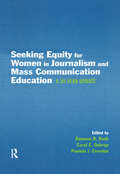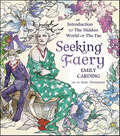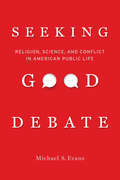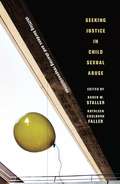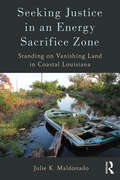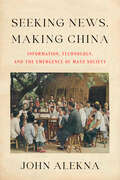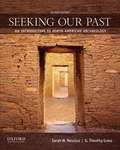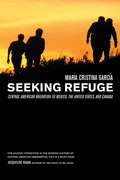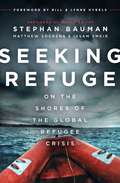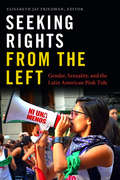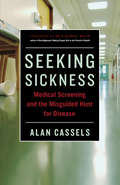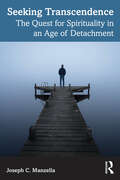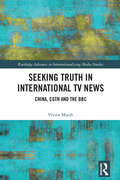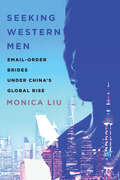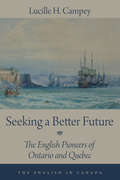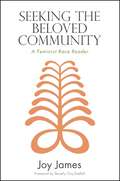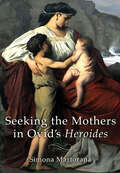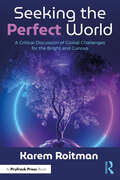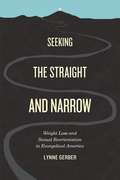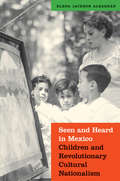- Table View
- List View
Seeking Equity for Women in Journalism and Mass Communication Education: A 30-year Update (Routledge Communication Series)
by Ramona R. Rush, Carol E. Oukrop and Pamela J. CreedonThis volume concentrates on the study and efforts of women and minority men to gain respect and parity in journalism and mass communication, and focuses on trends over the past three decades. Contributions to the volume provide a history of the equity efforts and offer updates on equity in the academy and in the professions. Theoretical and international perspectives on equity are also included, as are the concerns about equity from the new generations now coming into the profession. This anthology serves as a benchmark of women's current status in journalism and mass communication and provides a call to action for the future. As such, it is required reading for all concerned with establishing equity throughout the discipline.
Seeking Faery: An Introduction to the Hidden World of the Fae
by Emily CardingUnlock the Mysteries of FaeryEnter the world of Faery and meet its diverse inhabitants, including pixies, will o' the wisps, the Sidhe, and more. This enchanting book delves into their folklore and history as well as a variety of techniques for developing relationships with them. Emily Carding shares nearly two dozen voice- and movement-based exercises for all levels of ability, such as using a symbol as a gateway to Faery and taking an underworld journey to meet your Faery ally. You'll also discover how to honor faeries, connect deeply to nature, and uncover your unique gifts. Featuring numerous color illustrations by bestselling artist Siolo Thompson, this guide immerses you in Faery magic and shows you how to strengthen connections between our worlds.
Seeking Good Debate
by Michael S. EvansWhy do religion and science often appear in conflict in America's public sphere? In Seeking Good Debate, Michael S. Evans examines the results from the first-ever study to combine large-scale empirical analysis of some of our foremost religion and science debates with in-depth research into what Americans actually want in the public sphere. The surprising finding is that apparent conflicts involving religion and science reflect a more fundamental conflict between media elites and ordinary Americans over what is good debate. For elite representatives, good debate advances an agenda, but, as Evans shows, for many Americans it is defined by engagement and deliberation. This hidden conflict over what constitutes debate's proper role diminishes the possibility for science and religion to be discussed meaningfully in public life. Challenging our understanding of science, religion, and conflict, Seeking Good Debate raises profound questions about the future of the public sphere and American democracy.
Seeking Justice in Child Sexual Abuse: Shifting Burdens and Sharing Responsibilities
by Kathleen Coulborn Faller Karen StallerSt. Mary County is a small rural midwestern enclave with a unique approach to handling accusations of child sexual abuse. Hoping to spare children the trauma of lengthy court appearances and probing interrogations, St. Mary's professionals strive to obtain confessions from accused sex offenders rather than ask the victim to bear the burden of proof. Treating this county as a critical case study, scholars from a variety of fields come together to analyze this community's unique approach. They address relevant case law, innovative treatments for both victim and offender, and the social history of child sexual abuse as a national policy concern. They cover legal burdens and scientific methods, prosecutors and protocol, the interrogation of victims and suspects, the use of expert witnesses, defense strategies, and practice wisdom in videotaping. In addition, they examine the unfolding drama of a single legal case from incidence to conviction.The result is a fascinating dialogue that confronts the unique complexities of child sexual abuse for readers on all sides of the issue. Introducing a model that makes enormous headway in the pursuit of justice, fairness, and trauma treatment, this interdisciplinary text is an indispensible tool for all communities seeking redress.
Seeking Justice in an Energy Sacrifice Zone: Standing on Vanishing Land in Coastal Louisiana
by Julie K. MaldonadoSeeking Justice in an Energy Sacrifice Zone is an ethnography of the lived experience of rapid environmental change in coastal Louisiana, USA. Writing from a political ecology perspective, Maldonado explores the effects of changes to localized climate and ecology on the Isle de Jean Charles, Grand Caillou/Dulac, and Pointe-au-Chien Indian Tribes. Focusing in particular on wide-ranging displacement effects, she argues that changes to climate and ecology should not be viewed in isolation as only physical processes but as part of wider socio-political and historical contexts. The book is valuable reading for students and scholars in the fields of anthropology, sociology, geography, environmental studies and disaster studies as well as public policy and planning.
Seeking News, Making China: Information, Technology, and the Emergence of Mass Society
by John AleknaContemporary developments in communications technologies have overturned key aspects of the global political system and transformed the media landscape. Yet interlocking technological, informational, and political revolutions have occurred many times in the past. In China, radio first arrived in the winter of 1922-23, bursting into a world where communication was slow, disjointed, or non-existent. Less than ten percent of the population ever read newspapers. Just fifty years later, at the beginning of the Cultural Revolution, news broadcasts reached hundreds of millions of people instantaneously, every day. How did Chinese citizens experience the rapid changes in information practices and political organization that occurred in this period? What was it like to live through a news revolution? John Alekna traces the history of news in twentieth-century China to demonstrate how large structural changes in technology and politics were heard and felt. Scrutinizing the flow of news can reveal much about society and politics—illustrating who has power and why, and uncovering the connections between different regions, peoples, and social classes. Taking an innovative, holistic view of information practices, Alekna weaves together both rural and urban history to tell the story of the rise of mass society through the lens of communication techniques and technology, showing how the news revolution fundamentally reordered the political geography of China.
Seeking Our Past: An Introduction to North American Archaeology
by Sarah Neusius G. GrossThe authors include examples from both North American prehistory and history drawn from academic archaeology and Cultural Resource Management (CRM) in order to provide a broad overview of how the continent was settled, what archaeologists have learned about life across the North American culture areas, and how current archaeologists research our past.
Seeking Reconciliation in a Context of Coloniality: A Study of White People’s Approaches in a Multicultural South African church ((Re-)konstruktionen - Internationale und Globale Studien)
by Marcus GrohmannHow do white people handle their own dominance while striving for racial reconciliation in a concrete church context in Cape Town? Persisting effects of colonialism present a challenge to reconciliation efforts in settler-colonial societies. This book draws particular attention to the coloniality of knowledge in multicultural churches and denominations. Despite its ability to connect, English is here regarded as an obstacle to deeper cross-cultural understanding and appreciation. The findings of this ethnographic study reveal how – motivated by a ‘Hope for transformation from within’ – racial integration often took precedence over equity. Eurocentric leanings were found to be both acknowledged and downplayed. With the emphasis on inclusion and upliftment, the equally sought-after cultural diversity was limited by the inadvertent setting up of boundaries, particularly regarding language and theology. Grohmann concludes that the perceptible but not prominent mode of choosing vulnerability, i.e. relating on other people’s terms, constitutes a promising alternative to conventional ways of tackling inequalities. This decolonial approach to reconciliation would have the potential to advance both equity and equality.
Seeking Refuge: Central American Migration to Mexico, the United States, and Canada
by María Cristina GarcíaThe political upheaval in Nicaragua, El Salvador, and Guatemala had a devastating human toll at the end of the twentieth century. A quarter of a million people died during the period 1974-1996. Many of those who survived the wars chose temporary refuge in neighboring countries such as Honduras and Costa Rica. Others traveled far north, to Mexico, the United States, and Canada in search of safety. Over two million of those who fled Central America during this period settled in these three countries. In this incisive book, María Cristina García tells the story of that migration and how domestic and foreign policy interests shaped the asylum policies of Mexico, the United States, and Canada. She describes the experiences of the individuals and non-governmental organizations--primarily church groups and human rights organizations--that responded to the refugee crisis, and worked within and across borders to shape refugee policy. These transnational advocacy networks collected testimonies, documented the abuses of states, re-framed national debates about immigration, pressed for changes in policy, and ultimately provided a voice for the displaced. García concludes by addressing the legacies of the Central American refugee crisis, especially recent attempts to coordinate a regional response to the unique problems presented by immigrants and refugees--and the challenges of coordinating such a regional response in the post-9/11 era.
Seeking Refuge: On the Shores of the Global Refugee Crisis
by Stephan Bauman Matthew Soerens Dr Issam SmeirRecipient of Christianity Today's Award of Merit in Politics and Public Life, 2016 ------ What will rule our hearts: fear or compassion? We can't ignore the refugee crisis--arguably the greatest geo-political issue of our time--but how do we even begin to respond to something so massive and complex? In Seeking Refuge, three experts from World Relief, a global organization serving refugees, offer a practical, well-rounded, well-researched guide to the issue. Who are refugees and other displaced peoples? What are the real risks and benefits of receiving them? How do we balance compassion and security? Drawing from history, public policy, psychology, many personal stories, and their own unique Christian worldview, the authors offer a nuanced and compelling portrayal of the plight of refugees and the extraordinary opportunity we have to love our neighbors as ourselves.
Seeking Rights from the Left: Gender, Sexuality, and the Latin American Pink Tide
by Elisabeth Jay FriedmanSeeking Rights from the Left offers a unique comparative assessment of left-leaning Latin American governments by examining their engagement with feminist, women's, and LGBT movements and issues. Focusing on the “Pink Tide” in eight national cases—Argentina, Bolivia, Brazil, Chile, Ecuador, Nicaragua, Uruguay, and Venezuela—the contributors evaluate how the Left addressed gender- and sexuality-based rights through the state. Most of these governments improved the basic conditions of poor women and their families. Many significantly advanced women's representation in national legislatures. Some legalized same-sex relationships and enabled their citizens to claim their own gender identity. They also opened opportunities for feminist and LGBT movements to press forward their demands. But at the same time, these governments have largely relied on heteropatriarchal relations of power, ignoring or rejecting the more challenging elements of a social agenda and engaging in strategic trade-offs among gender and sexual rights. Moreover, the comparative examination of such rights arenas reveals that the Left's more general political and economic projects have been profoundly, if at times unintentionally, informed by traditional understandings of gender and sexuality. Contributors: Sonia E. Alvarez, María Constanza Diaz, Rachel Elfenbein, Elisabeth Jay Friedman, Niki Johnson, Victoria Keller, Edurne Larracoechea Bohigas, Amy Lind, Marlise Matos, Shawnna Mullenax, Ana Laura Rodríguez Gustá, Diego Sempol, Constanza Tabbush, Gwynn Thomas, Catalina Trebisacce, Annie Wilkinson
Seeking Sanctuary: A History of Refugees in Britain
by Jane Marchese Robinson“An entrancing read, illuminating how life in Britain has been influenced and enhanced by those who arrived, often with nothing except their skills.” —Babs Horton, author of Winter SwallowsSeeking Sanctuary explores the history of people looking for refuge in Great Britain. It starts with those Protestant refugees fleeing oppression and persecution from Catholic Spain who ruled the Netherlands in the sixteenth century. It traces successive waves of peoples in the context of why they fled. At various times this was due to religious persecution, political upheaval, war and ethnic cleansing.“The author writes from the perspective of her work with asylum seekers, which evidently generated her interest in Britain’s history as a refuge. Jane Marchese Robinson’s passion for displaced persons is apparent in her examples and case studies, and for anyone with an interest in, or connection with, the selected groups of refugees over the past 100 years, it will make interesting reading . . . The author demonstrates compassion for, and empathy with, the groups she examines, and many will find this the compelling aspect of the book.” —Association of Genealogists and Researchers in Archives“This is a wide-ranging book which explores these major refugee movements in depth and it is often emotional in its details.” —Bristol and Avon Family History Society
Seeking Sanctuary: Stories of Sexuality, Faith and Migration
by John MarnellA glimpse into the lives of LGBTQ migrants in Johannesburg, in their own words Seeking Sanctuary brings together poignant life stories from fourteen lesbian, gay, bisexual and transgender (LGBT) migrants, refugees and asylum seekers living in Johannesburg, South Africa. The stories, diverse in scope, chronicle each narrator’s arduous journey to South Africa, and their corresponding movement towards self-love and self-acceptance. The narrators reveal their personal battles to reconcile their faith with their sexuality and gender identity, often in the face of violent persecution, and how they have carved out spaces of hope and belonging in their new home country. In these intimate testimonies, the narrators’ resilience in the midst of uncertain futures reveal the myriad ways in which LGBT Africans push back against unjust and unequal systems.Seeking Sanctuary makes a critical intervention by showing the complex interplay between homophobia and xenophobia in South Africa, and of the state of sexual orientation and gender identity (SOGI) rights in Africa. By shedding light on the fraught connections between sexuality, faith and migration, this ground-breaking project also provides a model for religious communities who are working towards justice, diversity and inclusion.
Seeking Shelter: A Working Mother, Her Children, and a Story of Homelessness in America
by Jeff HobbsFrom the bestselling author of The Short and Tragic Life of Robert Peace, a powerful portrayal of American homelessness that follows a single mother of six in Los Angeles courageously struggling to keep her family together and her children in school amidst the devastating housing crisis.In the tradition of Evicted and Invisible Child, Jeff Hobbs masterfully explores America&’s housing crisis through the real-life story of Evelyn. This is Hobbs&’s first book since The Short and Tragic Life of Robert Peace that focuses on a single character and her extraordinarily illuminating journey. In 2018, poverty and domestic violence cast Evelyn and her children into the urban wilderness of Los Angeles, where she avoids the family crisis network that offers no clear pathway for her children to remain together and in a decent school. For the next five years, Evelyn works full time as a waitress yet remains unable to afford legitimate housing or qualify for government aid. All the while she strives to provide stability, education, loving memories, and college aspirations for her children even as they sleep in motels and in her car, living in fear of both her ex and the nation&’s largest child welfare agency. Eventually Evelyn encounters Wendi Gaines, a recently trained social worker who decades earlier survived her own abusive marriage and housing crisis. Evelyn becomes one of Wendi&’s first clients, and the relationship transforms them both. Told from the perspectives of Evelyn, Wendi, and Evelyn&’s teenaged son, Orlando, Seeking Shelter is a powerful and urgent exploration of the issues of homelessness, poverty, and education in America—a must-read for anyone interested in understanding not just social inequality and economic disparity in our society but also the power of a mother&’s love and vision for her kids.
Seeking Sickness: Medical Screening and the Misguided Hunt for Disease
by Alan Cassels&“Alan Cassels strips layers of expectation, hype, jargon, false-starts, and conflicts of interest off the medical screening mantra.&” —Nortin M. Hadler, author of Worried Sick Why wouldn&’t you want to be screened to see if you&’re at risk for cancer, heart disease, or another potentially lethal condition? After all, better safe than sorry. Right? Not so fast, says Alan Cassels. His Seeking Sickness takes us inside the world of medical screening, where well-meaning practitioners and a profit-motivated industry offer to save our lives by exploiting our fears. He writes that promoters of screening overpromise on its benefits and downplay its harms, which can range from the merely annoying to the life threatening. If you&’re facing a screening test for breast or prostate cancer, high cholesterol, or low testosterone, someone is about to turn you into a patient. You need to ask yourself one simple question: Am I ready for all the things that could go wrong? &“With engaging clarity backed by academic rigor, Cassels discusses a variety of popular investigational procedures . . . an excellent way to start the important process of self-education.&” —Quill & Quire &“Smartly written and very readable.&” —Brian Goldman, MD, author of The Secret Language of Doctors &“Cassels tackles this touchy topic, looking at it test by test. His overarching message is that modern medicine has &‘overpromised&’ with claims that screening will save our lives. He contends that with the lack of hard evidence on benefits, the evidence of harm from by such screening, as well as the multi-billion dollar interests at stake, we should approach this kind of screening with great precaution.&” —Canadian Women&’s Health Network
Seeking Spatial Justice (Globalization and Community #16)
by Edward W. SojaIn 1996, the Los Angeles Bus Riders Union, a grassroots advocacy organization, won a historic legal victory against the city&’s Metropolitan Transit Authority. The resulting consent decree forced the MTA for a period of ten years to essentially reorient the mass transit system to better serve the city&’s poorest residents. A stunning reversal of conventional governance and planning in urban America, which almost always favors wealthier residents, this decision is also, for renowned urban theorist Edward W. Soja, a concrete example of spatial justice in action.In Seeking Spatial Justice, Soja argues that justice has a geography and that the equitable distribution of resources, services, and access is a basic human right. Building on current concerns in critical geography and the new spatial consciousness, Soja interweaves theory and practice, offering new ways of understanding and changing the unjust geographies in which we live. After tracing the evolution of spatial justice and the closely related notion of the right to the city in the influential work of Henri Lefebvre, David Harvey, and others, he demonstrates how these ideas are now being applied through a series of case studies in Los Angeles, the city at the forefront of this movement. Soja focuses on such innovative labor–community coalitions as Justice for Janitors, the Los Angeles Alliance for a New Economy, and the Right to the City Alliance; on struggles for rent control and environmental justice; and on the role that faculty and students in the UCLA Department of Urban Planning have played in both developing the theory of spatial justice and putting it into practice.Effectively locating spatial justice as a theoretical concept, a mode of empirical analysis, and a strategy for social and political action, this book makes a significant contribution to the contemporary debates about justice, space, and the city.
Seeking Transcendence: The Quest for Spirituality in an Age of Detachment
by Joseph C. ManzellaSeeking Transcendence examines the various paths taken by those who have detached themselves from their traditional, institutional religious roots but are seeking non-traditional paths to spiritual experiences. Called the “nones” or "non-affiliated" in popular mass media, these include a significant number of Western folks who maintain a belief in God or at least consider themselves “spiritual but not religious”.Each chapter of the book explores these trends with a specific theme, as well as a case study based on the author’s ethnographic observation of alternative spiritual communities and practices in North America and Western Europe.Ultimately, this book shows how contemporary alternatives to traditional institutional religion appeal to nones, presenting the relevance of new religious movements and more secular spiritual paths to transcendence.
Seeking Truth in International TV News: China, CGTN and the BBC (Routledge Advances in Internationalizing Media Studies)
by Vivien MarshThis book puts CGTN (formerly CCTV-News) and the BBC’s international television news head-to-head, interrogating competing ‘truths’ in the exacting business of news reporting. Written by a media scholar and former long-serving BBC News journalist, Seeking Truth in International TV News asks if China’s English-language television news programmes are little more than state propaganda, and if the BBC can be viewed as a universal news standard to which all other broadcasters should aspire. Over 8 years of Xi Jinping’s rule, it investigates how the international TV news channels of CGTN and the BBC reported on Chinese politics, protests in Hong Kong, disasters, China in Africa, and insurgency and its suppression in Xinjiang. The comparison reveals uneven editorial imperatives at the Chinese broadcaster and raises questions about the BBC’s professed tenets of balance and impartiality. It also illustrates how Chinese journalists commit ‘small acts of journalism’ that push the boundaries of information control. A rigorous analysis of reportage from the two channels, this book will be relevant to scholars of global media, journalism, international relations and public diplomacy. It will also interest those in academia, the media and international affairs who want to examine the nature of news and ‘soft power’ in a comparative context.
Seeking Western Men: Email-Order Brides under China's Global Rise (Globalization in Everyday Life)
by Monica LiuCommercial dating agencies that facilitate marriages across national borders comprise a $2.5 billion global industry. Ideas about the industry are rife with stereotypes—younger, more physically attractive brides from non-Western countries being paired with older Western men. These ideas are more myth than fact, Monica Liu finds in Seeking Western Men. Her study of China's email-order bride industry offers stories of Chinese women who are primarily middle-aged, divorced, and proactively seeking spouses to fulfill their material and sexual needs. What they seek in their Western partners is tied to what they believe they've lost in the shifting global economy around them. Ranging from multimillionaire entrepreneurs or ex-wives and mistresses of wealthy Chinese businessmen, to contingent sector workers and struggling single mothers, these women, along with their translators and potential husbands from the US, Canada, and Australia, make up the actors in this multifaceted story. Set against the backdrop of China's global economic ascendance and a relative decline of the West, this book asks: How does this reshape Chinese women's perception of Western masculinity? Through the unique window of global internet dating, this book reveals the shifting relationships of race, class, gender, sex, and intimacy across borders.
Seeking a Better Future: The English Pioneers of Ontario and Quebec
by Lucille H. CampeyMost emigration from England was voluntary, self-financed, and pursued by people who, while expecting to improve their economic prospects, were also critical of the areas in which they first settled. The exodus from England that gathered pace during the 19th century accounted for the greatest part of the total emigration from Britain to Canada. And yet, while copious emigration studies have been undertaken on the Scots and the Irish, very little has been written about the English in Canada. Drawing on wide-ranging data collected from English record offices and Canadian archives, Lucille Campey considers why people left England and traces their destinations in Ontario and Quebec. A mass of detailed information relating to pioneer settlements and ship crossings has been distilled to provide new insights on how, why, and when Ontario and Quebec acquired their English settlers. Challenging the widely held assumption that emigration was primarily a flight from poverty, Campey reveals how the ambitious and resourceful English were strongly attracted by the greater freedoms and better livelihoods that could be achieved by relocating to Canada’s central provinces.
Seeking the Beloved Community: A Feminist Race Reader (SUNY series, Philosophy and Race)
by Joy JamesWritten over the course of twenty years, the essays brought together here highlight and analyze tensions confronted by writers, scholars, activists, politicians, and political prisoners fighting racism and sexism. Focusing on the experiences of black women calling attention to and resisting social injustice, the astonishing scale of mass and politically driven imprisonment in the United States, and issues relating to government and civic powers in American democracy, Joy James gives voice to people and ideas persistently left outside mainstream progressive discourse—those advocating for the radical steps necessary to acknowledge and remedy structural injustice and violence, rather than merely reforming those existing structures.
Seeking the Mothers in Ovid's "Heroides"
by Simona MartoranaSeeking the Mothers in Ovid's "Heroides" explores Ovid's reconceptualization of the heroines' maternal experience. Rather than aligning them with the stereotypical roles of Roman women, motherhood enables the Ovidian heroines to challenge traditional norms with irreverent perspectives on gender categories and familial relationships. To confront these perspectives and overcome the dialectic between the (male) voice of the poet and the (female) voice of the heroines, Seeking the Mothers in Ovid's "Heroides" argues for a form of polyphonic "cooperation" between the two voices, thus providing new angles on ironical discourse and gender fluidity within the Heroides.By reading the Heroides both through feminist theory and against Ovid's poetic production, Simona Martorana provides a novel approach to describe how motherhood enhances the heroines' agency, drawing on works of Kristeva, Irigaray, Butler, Mulvey, Cavarero, Braidotti, and Ettinger. The application of theory is flexible throughout Seeking the Mothers in Ovid's "Heroides" and tailored to the nuances of specific passages rather than being uniformly imposed on the ancient text.Seeking the Mothers in Ovid's "Heroides" reveals how the irony, ambiguity, and polyphony intrinsic to Ovid's poetry are amplified by the heroines' poetic voices. Martorana breaks new ground by incorporating contemporary feminist theories within the analysis of the Heroides and provides an original comprehensive analysis of motherhood that encompasses other Ovidian works, Latin poetry, and classical literature more broadly.
Seeking the Perfect World: A Critical Discussion of Global Challenges for the Bright and Curious
by Karem RoitmanConsider this book your invitation to the most exciting party of the century. We have invited you and some of the greatest minds of our species to dance, share cake, and ponder the age-old question: how can we make our world better? Seeking the Perfect World guides readers through thoughtful discussions of twenty-first-century challenges while providing everything needed to critically engage with current events and personal dilemmas.This book explores topics humans have discussed for centuries … and more recent developments. We discuss what is human nature, why humans go to war, international relations, education, animal rights, transhumanism, artificial intelligence, and more! Chapters introduce readers to different philosophies (and philosophers) and prompt nuanced reasoning via Socratic questions and thought experiments. Not only will this book enable readers to understand the complexities of some of the most pressing global challenges, but it will also provide a grounding on philosophical, sociological, and economic thinking and ideas.Whether you are dipping your toes into philosophy for the first time, or you are a bright, curious teen seeking interesting conversations on the current events and global challenges, or a parent seeking ways to discuss difficult topics with your child – this book will provide you with the language and strategies needed to understand your own views and feelings while engaging in civic discourse. Come chat with philosophers, challenge your critical thinking, and expand your understanding of our world: past, present, and future.
Seeking the Straight and Narrow: Weight Loss and Sexual Reorientation in Evangelical America
by Lynne GerberLosing weight and changing your sexual orientation are both notoriously difficult to do successfully. Yet many faithful evangelical Christians believe that thinness and heterosexuality are godly ideals—and that God will provide reliable paths toward them for those who fall short. Seeking the Straight and Narrow is a fascinating account of the world of evangelical efforts to alter our strongest bodily desires. Drawing on fieldwork at First Place, a popular Christian weight-loss program, and Exodus International, a network of ex-gay ministries, Lynne Gerber explores why some Christians feel that being fat or gay offends God, what exactly they do to lose weight or go straight, and how they make sense of the program’s results—or, frequently, their lack. Gerber notes the differences and striking parallels between the two programs, and, more broadly, she traces the ways that other social institutions have attempted to contain the excesses associated with fatness and homosexuality. Challenging narratives that place evangelicals in constant opposition to dominant American values, Gerber shows that these programs reflect the often overlooked connection between American cultural obsessions and Christian ones.
Seen and Heard in Mexico: Children and Revolutionary Cultural Nationalism (The Mexican Experience)
by Elena Jackson AlbarranDuring the first two decades following the Mexican Revolution, children in the country gained unprecedented consideration as viable cultural critics, social actors, and subjects of reform. Not only did they become central to the reform agenda of the revolutionary nationalist government; they were also the beneficiaries of the largest percentage of the national budget.While most historical accounts of postrevolutionary Mexico omit discussion of how children themselves experienced and perceived the sudden onslaught of resources and attention, Elena Jackson Albarrán, in Seen and Heard in Mexico, places children’s voices at the center of her analysis. Albarrán draws on archived records of children’s experiences in the form of letters, stories, scripts, drawings, interviews, presentations, and homework assignments to explore how Mexican childhood, despite the hopeful visions of revolutionary ideologues, was not a uniform experience set against the monolithic backdrop of cultural nationalism, but rather was varied and uneven. Moving children from the aesthetic to the political realm, Albarrán situates them in their rightful place at the center of Mexico’s revolutionary narrative by examining the avenues through which children contributed to ideas about citizenship and nation.
